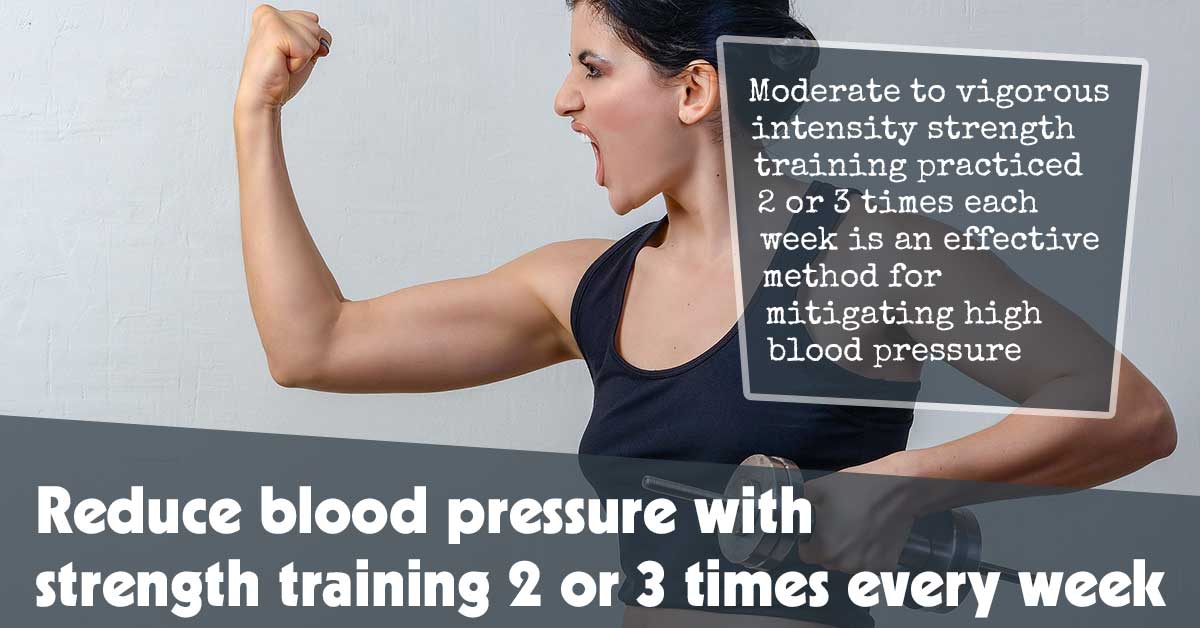According to a study, moderate to vigorous intensity strength training practiced 2 or 3 times each week is an effective method for mitigating high blood pressure.1✅ JOURNAL REFERENCE
DOI: 10.1038/s41598-022-26583-3
Blood pressure reduction by way of aerobic exercise is well researched, but few studies have been performed on strength exercise’s effects on high blood pressure.
More than 21,000 studies were analyzed for this review and a Cochrane meta-analysis was also carried out. The review focused on the effects of variables which included training dose-response, age, load, frequency, and volume.
Cardiovascular diseases are the main cause of death globally, and hypertension accounts for 13.8% of cardiovascular disease deaths. High blood pressure is when systolic blood pressure is higher than 140 mmHg and/or diastolic pressure is higher than 90 mmHg. Hypertension is a multifactorial condition triggered by issues such as a sedentary lifestyle, smoking, excess alcohol consumption, and an unhealthy diet.
Although strength training is a known option to help manage blood pressure, there has been insufficient evidence as to the most effective protocol. This study involved 253 hypertensive individuals aged 59.66 on average, with the meta-analysis focusing on baseline and post-training high blood pressure responses to studies that evaluated the impact of training for 8 weeks or more.
An average of 8 – 10 weeks of strength training resulted in a 10 mmHg systolic pressure reduction and a 4.79 mmHg diastolic pressure reduction. Effective results appeared about the 20th training session. Blood pressure stayed reduced for approximately 14 weeks after the training stopped.
A total of 21,132 studies were analyzed for this systematic review to find strong evidence of the impact of strength training on high blood pressure. Evidence was found in earlier studies, but this study gathered other evidence on the influence of load, age, frequency, and intensity. After 21,035 studies were excluded that didn’t fulfill the objectives, 43 of the remaining 97 studies were excluded because of duplication, leaving 54 studies for analysis with 14 considered relevant enough to be included in the review.
The analysis results revealed that strength training in loads of moderate to vigorous intensity was the most effective for reducing blood pressure, at a minimum frequency of twice a week, and a duration minimum of 8 weeks.
Loads of moderate to vigorous intensity were categorized as over 60% of the heaviest weight that could be lifted just once by the participants, known as the 1 repetition maximum, so that for a 1 repetition maximum of 10 kg a training load over 6 kg would be the most effective.
The majority of study participants were between the ages of 60 and 68. A subgroup analysis found more about how age influenced the impact of strength training, which revealed significantly more blood pressure reduction in the 18 to 50 age group compared to the 51 to 70 age group.
Previous research has shown that strength training increases heart rate, as well as nitrous oxide production, which promotes vasodilation by the expansion of the diameter of blood vessels, and boosts the flow of blood.
Long term, it facilitates adaptations that include improved heart efficiency, a reduced resting heart rate, a reduction in blood pressure, and higher VO2max, which is the maximum oxygen consumption rate attainable while exercising vigorously. VO2max is associated with cardiovascular health and is normally measured in milliliters of oxygen/kilogram of body weight/minute.
Some of the analysis limitations were the inclusion of individuals taking antihypertensive medication in 11 of the 14 studies, which included ACE inhibitors beta-blockers, calcium channel blockers, and diuretics. Also, in some of the studies women and men were included in the same group which prevented a gender-sensitive analysis.



